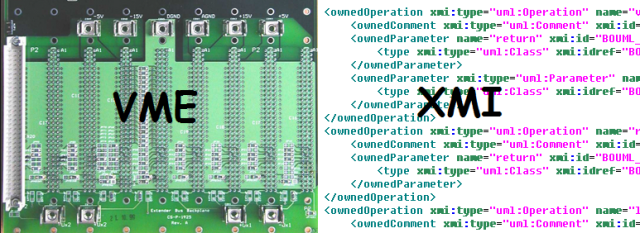On the left is the VMEbus, a hardware bus specification created by Motorola at the time of the 68000 CPU. It uses the Eurocard physical card, connectors and mechanicals (DIN 41612), and adds an electrical/signalling specification (i.e. what do all those connectors do?). The overall specification was standardised as IEC 821 ‘ VMEbus’ (VME = ‘VersaModule Eurocard’). This is a standard. I’ll tell you why in a moment.
On the right is XMI, the OMG’s XML meta-data interchange standard (ISO/IEC 19503:2005). This should be a standard, but isn’t. What’s the difference?
I’ll tell you, without even going through any analysis of these standards, or the history of their development.
The gold standard for something to be called a ‘standard’ should be:
- if any two implementers (typically companies), unknown to each other, and not in communication, can follow the standard as published and as a result, build equipment that interoperates perfectly, according to the standard.
This is the case with VMEbus. I worked in a company years ago that made and also bought VME cards, and bought VMEbus cages. This all worked together. There were no phone calls, meetings, or other communications required to do this. It’s routine in the control systems and other industries that use VMEbus.
In contrast, XMI is (in)famous for its poor implementation in tools, and the inability of tools to reliably use it to share UML models. This is partly because UML itself is badly specified in parts (generics) and too complicated to understand clearly in many places. Try putting ‘problems with XMI’ into Google… (By the way, this isn’t because OMG is a bad standards body; on the contrary, it is much better than most in requiring standards to have 2 independent implementations before release, like IETF. Something else went wrong here…)
If we were to investigate standards in e-health, we would come up nearly empty-handed. Most officially published standards can only be made to work by national standards bodies who lock down all the unknowns; and/or by IHE profiling. This is routinely done, and sometimes succeeds, to my knowledge, so those national standards or profiles could be considered standards. But now it means we have a national ‘admission message’ profile in multiple countries. This doesn’t help industry produce an administration system product that can deal with any admission event – they have to know about numerous national standards ‘profiles’ all over the place.
Doing this is also expensive. Should we have expected that the official specifications would be standards from the outset?
Some standards in health IT are simply used as an ‘inspiration’ for building things, and are freely adapted and mangled. Each of those resulting systems might be good on its own, but none of them will ever interoperate. Another standard will be needed for that.
Next post… what it would take to make proper standards in health IT.


